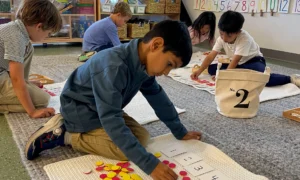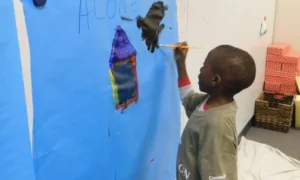The abysmal state of knowledge development and its dissemination in youth work is captured by two items among the avalanche of newsletters, reports, books, videos, DVDs and e-mail newsletters delivered daily to Youth Today. Among recent arrivals are the Catalyst, the house organ of the D.C.-based National Crime Prevention Council (NCPC), the winter issue of New Directions for Youth Development, a quarterly journal published by Jossey-Bass.
House Trained
First, the poop. The normal lifespan of a dog is eight to 16 years. That may explain the acute dementia that has clouded the brain of McGruff, the 25-year-old mascot of NCPC. Dressed in a trench coat that would send many a teen to the vice principal’s office, McGruff has been relentlessly promoted, with lavish taxpayer dollars, as an “icon” of “changing our communities through crime prevention.”
Absent any substantive policy or programmatic agenda, the NCPC will, we are breathlessly informed, be re-branding McGruff and his juvenile sidekick, Scruff. How will NCPC and its new CEO, retired Gen. Al Lenhardt, use its $5.25 million in non-competitive earmarks from Congress – an institution in which a kennel full of McGruffs, or better still, rottweilers, could be productively set loose to ferret out criminal behavior?
In the 20 pages of goofy vapidness of the March 2005 issue of Catalyst (circulation: 16,000), McGruff appears 23 times, not counting paw prints galore. Readers can order such 25th anniversary Rebuilding the Brand items as “golf accessory packages,” or “Retro McGruff T-Shirts” – just the outfit for chowing down at Applebee’s Restaurant, one of NCPC’s dogged partners in crime prevention.
The youth development credo of NCPC’s former CEO, Jack Calhoun, is in the dog house. Surprisingly, NCPC’s always-taxing editorial challenge of pushing crime prevention without mentioning that dirty four-letter word, “guns,” did slip into print. Little Bryan of Littleton, Colo. writes, “I have bulies telling me what to do. And this kid has a gun and he want me to shote someone. So can you please send the book to me.”
So to prevent crime, you write for a coloring book? Even the NRA’s bird-brained Eddie the Eagle’s advice, “tell an adult,” is better than that. Hey, Bryan, tell your local police or school safety officer about the kid with the gun. By now, the people in Littleton have got to know more about bullies and pistol-packin’ tots and teens than McGruff does.
Of course, McGruff and the whole NCPC operation have spent 25 years in obedience school learning to avoid the lash of congressional Republicans, whose earmarks are essential, lest McGruff and Scruff are sold off to Taiwan for a power lunch.
Strain to Train
Now the scoop.
Few would confuse a typical youth worker – including those in the management ranks – with a bookworm. Most trade books, reports and studies go unread and unremarked upon. While in most cases only the authors of such works have reasons for disappointment, there are exceptions.
The winter 2004 issue of the quarterly New Directions for Youth Development is a gem of an exception. This edition, entitled “Professional Development for Youth Workers,” has seven brief essays on a topic that many in the youth field believe should be priority No. 2 (just behind more money). It is edited by Pam Garza, director of the National Youth Development Learning Network at the National Human Services Assembly and the National Collaboration for Youth; Lynne Borden, an associate professor and extension specialist in family studies and human development at the University of Arizona; and Kirk Astroth, director of the 4-H Center for Youth Development at Montana State University-Bozeman, and past president of the National Association of Extension 4-H Agents.
The authors lay out the history and current status of America’s sputtering attempts to develop a training regimen for youth worker competence that is linked (here’s the rub) to a presumptive increase in wages for those judged to be qualified. The editors leap over those sterile, definitional conversations about youth and the youth service by quoting former National Urban League CEO Hugh Price, who said, “Youth development is what you’d do for your own kid on your best day.”
Youth Today’s readers will find familiar bylines within these hundred pages. Jane Quinn, Andrew Hahn and Karen Pittman are regular columnists for this journal. Quinn’s history of training reaches back 30 years, to the University of Minnesota’s National Youth Worker Education Project, funded by the Lilly Endowment, which sought to instill professional standards into staff training.
Since then, there has been a zigzagging, stop-and-go parade of national efforts to train youth workers. Few ventures have been linked in any substantive way to the kind of return on educational investment that teachers, social workers and many other helping professions, as well as policy-makers, take for granted.
While Pittman’s view that training in the youth work field has made “great progress” in the past 15 years is a stretch, there is no disputing that there has been progress, or at least heightened activity. The youth program manager who is willing to commit a few hours (and $29) to read these pages will learn of dozens of promising efforts. Some are linked to higher education (especially community colleges), some stand alone and some – such as the YMCA and Boys & Girls Clubs of America – are in-house programs open to employees and supporters only. In particular, the advances in developing standards for staff are impressive. These include Core Competencies in Youth Work, from the Fund for the City of New York, developed by Linda Pitts and Peter Klienbard, and the National Collaboration for Youth’s Youth Development Work Competencies.
A chapter on Achieve Boston, authored by the journal’s editor-in-chief and Harvard Graduate School of Education professor Gil Noam and others, describes how a newly hired (and untrained) youth worker’s zeal soon turns to frustration.
“You also know that this training will not, in any clear and direct way, translate into higher pay for you or more responsibility,” they write. “You hate the thought of leaving the field, but you are beginning to think about it.”
Virtually all of the Journal’s authors live off the largess of foundations and federal agencies, so don’t expect much insight into funder fickleness. Many of the stalwarts of field-building and youth worker training in the 1990s have largely gone missing in recent years.
These include New York’s Ford and Wallace foundations (the latter of which spent $55 million over a 15-year period, getting excellent results), Kansas City’s Kauffman Foundation (which severely narrowed the focus of its once stellar Youth Development program in 2003), California’s Packard (which ended its national youth program in 2003) and the Lilly Endowment (except for Indiana and a limited national program).
There have been two significant federally supported efforts aimed at training line workers in recent years. Advancing Youth Development, funded in 1996 by the U.S. Office of Juvenile Justice and Delinquency Prevention, resulted in a training curriculum developed by the National Network for Youth and Elaine Johnson, director of the Academy for Educational Development’s National Training Institute for Community Youth Work. It has had limited impact on the field so far.
In 2001, the U.S. Employment and Training Administration’s Office of Youth Programs, directed by Lorenzo Harrison, launched a Youth Development Practitioner Apprenticeship Program (YDPA). Dreamed up during the Clinton administration, the Department of Labor (DOL) program aimed to train 19- to 20-year-olds to advance from unskilled apprentices to journeymen youth workers, who would eventually or concurrently earn college degrees, then, it was hoped, stay in the youth service field.
The DOL awarded grants ranging from $86,000 to $179,000 to such national groups as the YMCA of the USA, the National 4-H Council and YouthBuild USA, and to local groups such as the West Fresno Schools, the Milwaukee Private Industry Council and the Urban League of Broward County, Fla. With a $249,000 grant, a clearinghouse to promote the effort was set up at the Sar Levitan Center at Johns Hopkins University, and was directed by Marion Pines.
While the target groups proved to be a little too young – Britain begins training in earnest for qualified youth workers at age 21 – the results have been impressive, especially given the miserly $2.42 million invested by the DOL. In Kansas City, for example, YouthNet, a collaboration of 18 agencies, teamed up with Johnson’s center at the Academy for Educational Development to implement the Advancing Youth Development curriculum in three youth-serving agencies.
One such agency is Whatsoever Community Center, run by Charlie Gascich. It hired Nancy Dooley, a Hispanic 19-year-old neighborhood resident, at $8.50 per hour. She has almost completed the two-year apprenticeship. Thanks to the training, she now receives $10 per hour to work full-time at the small, 92-year-old agency’s youth program. Would Dooley have gotten a pay raise without the training? “Not here,” says Gascich, who struggles to keep his agency and its staff of nine afloat in the impoverished Blue Valley neighborhood.
That’s just one example of what YDPA did during its brief two years of grant making. But long-haul upgrades to the workforce as a partial solution to gangs, drugs, crime, etc., are beyond the intellectual grasp of the Bush administration’s political appointees at DOL. Still, even without continuing DOL support, YDPA youth workers are in training at 41 agencies across the country. Such is the need for and power of sustained, intentional staff training, if given just a little push.
The Bull Dog Way
Even as American youth-serving agencies grapple with staffing and training, our British cousins, once 30 years ahead of us in youth work, have opened the knowledge and training gap by yet another decade. Pittman’s excellent contribution in the concluding chapter on youth work in the United Kingdom can be read two ways. It could indicate that Americans, compared with the British, form a hopelessly backward, semi-civilized society that should just give up on this squishy youth development stuff, build more prisons and make everyone carry a concealed weapon.
Or it could mean that we should learn from the marvelous achievements in youth work of our former colonial ruler, as I’ve been writing about since 1976. Pittman writes, “I am convinced, there is not a more elegant statement of the purpose of youth work than that offered by the British government as articulated in the National Occupational Standards for Youth Work: ‘The key purpose of youth work is to work with young people to facilitate their personal, social, and educational development, and enable them to gain a voice, influence, and place in society in a period of transitions from dependence to independence.’ This definition does not bother with where or when the work is done, but only with why and how.”
Now Britain is upgrading through its Transforming Youth Work initiative, championed by such groups as the National Youth Agency (where this youth worker/reporter spent a mind-altering year-long sabbatical a quarter-century ago) and the Community and Youth Worker Union, both of which strive to ensure that higher competencies are tied directly to higher wages.
But our laggard country does have committed and professionally astute people, too. In November 2004, 35 people gathered at the Wingspread Conference Center in Wisconsin to map out a plan for “Attracting, Developing and Sustaining Youth Workers for the Next Generation: A Collaborative Strategy for Creating a National System.”
Out of that gathering has come the Next Generation Youth Work Coalition, made up of 35 groups (most of them national), which Garza says “is trying to build a national system of professional development for youth workers.” The group is led by Garza, Pittman and Deborah Craig, president of YouthNet of Greater Kansas City, and will operate from Pittman’s Forum for Youth Investment office in Washington, D.C.
The prospects for continued advancement in the national workforce training agenda are now principally in the hands of just four funders: the Edna McConnell Clark Foundation and Atlantic Philanthropies, both in New York, the Annie E. Casey Foundation in Baltimore, Md., and the Charles Stewart Mott Foundation in Flint, Mich. Clark is handsomely funding a small stable of direct service agencies with the goal of growth in number of youth served and excellence in service provision. A few national groups receive Clark support, including Boys & Girls Clubs of America, Friends of the Children and Girls, Inc.
Mott has been the leading national champion of expanding both after-school programs and service provider training through its partnership with the U.S. Department of Education and with others through the Afterschool Alliance. Don’t tell the education lobby, but “after school” and “youth work” are terms without a real world difference for kids from middle school on up.
For example, Noam et al. write in New Directions for Youth Development, that Achieve Boston’s training efforts have “integrated the core competencies for two traditionally separate fields – afterschool and youth work – to create a set of 11 competency areas that are important to both.”
Atlantic Philanthropies’ entrance into infrastructure development and training is eagerly awaited by the field. Atlantic Philanthropies’ previous grant-making efforts have had considerable impact on such areas as nonprofit management and services to the elderly. To date, Atlantic Philanthrophies support has gone to Pittman’s Forum for Youth Investment and to Dr. Michael Carrera at New York’s Children’s Aid Society (a $10 million grant) to expand the Carrera Adolescent Pregnancy Prevention Program nationwide.
Finally, the Annie E. Casey Foundation has put some of its money where its mouth is on how to improve wages, training and working conditions across the human services field. In 2003, Casey issued its “Unsolved Challenge of System Reform: Condition of the Frontline Human Services Workforce,” authored by Janice Nitolli. It’s the only study to examine the incomes, educational backgrounds and opinions of the human service field’s estimated three million wage-earners.
Now Casey’s Human Service Workforce Initiative (HSWI) has taken on a new identity, Cornerstones For Kids (C4K). It’s a spin-off of Houston-based Cornerstone Consulting Group, lead by two former Casey Foundation senior staffers, Sharon Edwards and Ira Cutler. Cutler is based in Port Chester, N.Y.
In announcing the new venture, Casey’s vice president of system and service reform wrote to colleagues that the foundation had “concluded that the best long-term future for HSWI will be achieved by lodging responsibility for its next stages in a nonprofit organization that is both closely linked to Casey, but independent.” C4K received a $1.75 million grant, renewable annually, to promote national reforms and improvements in the frontline of the human service workforce.
To do that, the nonprofit C4K will make small grants to qualified parties in the fields of youth services, child welfare, child care, juvenile justice and employment and training fields. So far, two grants have been made in the youth field. The Academy for Educational Development’s Center for Youth Development and Policy Research, run by Bonnie Politz, received $33,000 to study turnover and attrition problems and solutions. And a grant of $85,000 went to the Forum for Youth Investment, where Pittman and Garza will continue to work on training issues.
It speaks volumes about national priorities and the state of community services and youth work that a useless newsletter like Catalyst can go “free” (i.e., paid for by the taxpayers) to 16,000 alleged readers, while an invaluable volume like New Directions for Youth Development, with a circulation of about 1,000, costs $29 per issue and is unlikely to reach even one percent of people in the youth field who are paid to train frontline youth workers.
Contact: National Crime Prevention Council, (202) 466-6272, www.ncpc.org; Professional Development for Youth Workers: New Directions for Youth Development, No. 104, Jossey-Bass. (877) 762-2974, www.josseybass.com; C4K (713) 627-2322; Edna McConnell Clark Foundation, (212) 551-9100, www.emcf.org; Atlantic Philanthropies (212) 916-7300, www.atlanticphilanthropies.org; Charles Stewart Mott Foundation (810) 238-5651, www.mott.org; Annie E. Casey Foundation (410)-547-6600, www.aecf.org.































